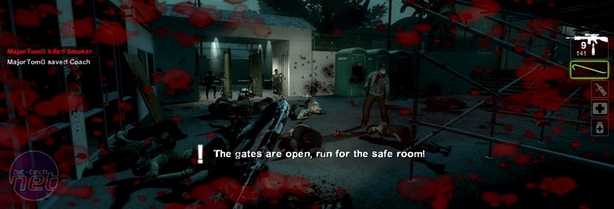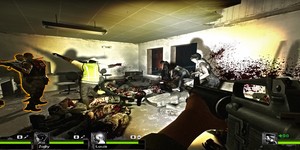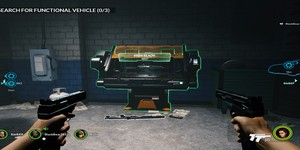Campaign Mode
This new injection of exuberance does have a cost though and, while the levels are now more lively and imaginative than the nameless city streets and empty forests of the original Left 4 Dead, there are changes which we’re less comfortable with.The characters, for example. Gone are Zoey, Bill, Louis and Francis and replacing them are Nick, Coach, Ellis and Rochelle – a new quartet who, because of their more focused histories and origins, we just don’t empathise with as much.
While Louis and Zoey were characters which the average geek could relate too and Bill and Frank were the heroes we could aspire to, this new team has no such everyman quality. They exist separate from any archetypes we understand, primarily because they so frequently talk about who they are and where they are from – something that is the root of much of the humour and new storytelling techniques used in Left 4 Dead 2.
Then again, the loss of the original characters is a small price to pay and begrudged though we were to the new crew we soon warmed up to them. The back and forth between Ellis and Coach is particularly well done, with the diminutive mechanic forever having his stories cut short by the colossal gym teacher or being teased for his tiny stature by con-man Nick.
Rochelle, the local TV producer, stands out as perhaps the most silent of the new characters but even she has a few memorable lines – especially in the opening levels to the first campaign.
The chapters of the campaign have been noticeably fleshed out too for Left 4 Dead 2, with both individual levels and entire arcs proving a lot longer. There’s now five missions to each campaign – or four missions and a finale – and there’s a total of five campaigns too, an improvement over the original’s four.
The basic structure of each is still the same as it ever was; you begin stranded and have to make your way to safety, stopping for level changes at the red-doored saferooms that have been reinforced to withstand a zombie assault. Each mission usually features a climax event too, which is a player-initiated zombie swarm that must be survived to reach the end of the level.
It’s these climax events which deliver one of the best variations in pace compared to Left 4 Dead, as the original game only really had static climaxes – where you hold a line until the zombie numbers are depleted and you can continue. Left 4 Dead 2 favours a moving climax however, where you must actually take a direct action to stem the flow of zombies. Some of these events seem a little out of place but others, like Dark Carnival’s rollercoaster event where players must run along the rails in order to shut off the alarm at the far end, feel like a natural use of the setting.
Even better, the finales that mark the close of each chapter have been envigoured too. Again, our favourite is from Dark Carnival – the survivors must turn on the pyrotechnic show of a rock concert to signal a helicopter, making use of fireworks and the band’s abandoned drug supply to keep themselves going.
Dark Carnival is far from the only event to stand out though and each campaign boasts its own merits. The campaign included in the demo, The Parish, didn’t wow us from the levels that Valve gave away for free – but it rises to an incredible crescendo when the survivors must escape New Orleans by running a zombie-packed bridge. Weaving through the cars and fighting against the whim of the enhanced AI director is a load of fun and it’s clear that the entire location has been designed to allow specific boss infected maximum effect. In Versus play both the Tank and Smoker come into their own for this level, while other, new bosses shine in other levels.

MSI MPG Velox 100R Chassis Review
October 14 2021 | 15:04












Want to comment? Please log in.